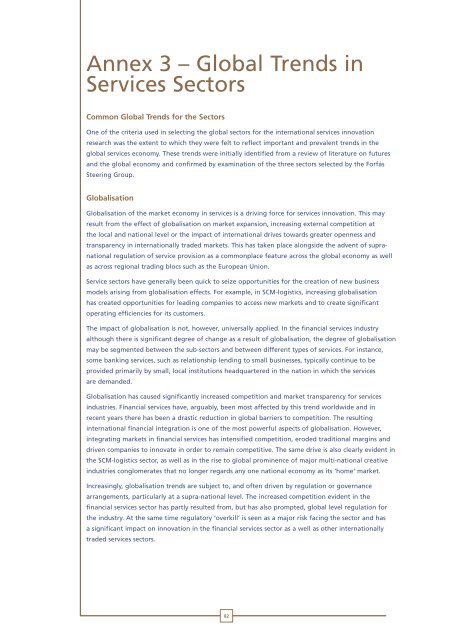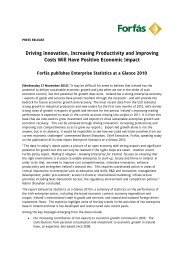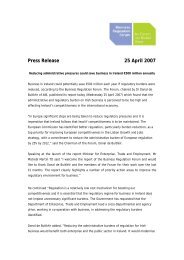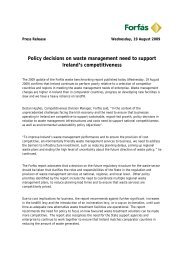Services Innovation in Ireland - Options for ... - Europe INNOVA
Services Innovation in Ireland - Options for ... - Europe INNOVA
Services Innovation in Ireland - Options for ... - Europe INNOVA
You also want an ePaper? Increase the reach of your titles
YUMPU automatically turns print PDFs into web optimized ePapers that Google loves.
Annex 3 – Global Trends <strong>in</strong><br />
<strong>Services</strong> Sectors<br />
Common Global Trends <strong>for</strong> the Sectors<br />
One of the criteria used <strong>in</strong> select<strong>in</strong>g the global sectors <strong>for</strong> the <strong>in</strong>ternational services <strong>in</strong>novation<br />
research was the extent to which they were felt to reflect important and prevalent trends <strong>in</strong> the<br />
global services economy. These trends were <strong>in</strong>itially identified from a review of literature on futures<br />
and the global economy and confirmed by exam<strong>in</strong>ation of the three sectors selected by the Forfás<br />
Steer<strong>in</strong>g Group.<br />
Globalisation<br />
Globalisation of the market economy <strong>in</strong> services is a driv<strong>in</strong>g <strong>for</strong>ce <strong>for</strong> services <strong>in</strong>novation. This may<br />
result from the effect of globalisation on market expansion, <strong>in</strong>creas<strong>in</strong>g external competition at<br />
the local and national level or the impact of <strong>in</strong>ternational drives towards greater openness and<br />
transparency <strong>in</strong> <strong>in</strong>ternationally traded markets. This has taken place alongside the advent of supra-<br />
national regulation of service provision as a commonplace feature across the global economy as well<br />
as across regional trad<strong>in</strong>g blocs such as the <strong>Europe</strong>an Union.<br />
Service sectors have generally been quick to seize opportunities <strong>for</strong> the creation of new bus<strong>in</strong>ess<br />
models aris<strong>in</strong>g from globalisation effects. For example, <strong>in</strong> SCM-logistics, <strong>in</strong>creas<strong>in</strong>g globalisation<br />
has created opportunities <strong>for</strong> lead<strong>in</strong>g companies to access new markets and to create significant<br />
operat<strong>in</strong>g efficiencies <strong>for</strong> its customers.<br />
The impact of globalisation is not, however, universally applied. In the f<strong>in</strong>ancial services <strong>in</strong>dustry<br />
although there is significant degree of change as a result of globalisation, the degree of globalisation<br />
may be segmented between the sub-sectors and between different types of services. For <strong>in</strong>stance,<br />
some bank<strong>in</strong>g services, such as relationship lend<strong>in</strong>g to small bus<strong>in</strong>esses, typically cont<strong>in</strong>ue to be<br />
provided primarily by small, local <strong>in</strong>stitutions headquartered <strong>in</strong> the nation <strong>in</strong> which the services<br />
are demanded.<br />
Globalisation has caused significantly <strong>in</strong>creased competition and market transparency <strong>for</strong> services<br />
<strong>in</strong>dustries. F<strong>in</strong>ancial services have, arguably, been most affected by this trend worldwide and <strong>in</strong><br />
recent years there has been a drastic reduction <strong>in</strong> global barriers to competition. The result<strong>in</strong>g<br />
<strong>in</strong>ternational f<strong>in</strong>ancial <strong>in</strong>tegration is one of the most powerful aspects of globalisation. However,<br />
<strong>in</strong>tegrat<strong>in</strong>g markets <strong>in</strong> f<strong>in</strong>ancial services has <strong>in</strong>tensified competition, eroded traditional marg<strong>in</strong>s and<br />
driven companies to <strong>in</strong>novate <strong>in</strong> order to rema<strong>in</strong> competitive. The same drive is also clearly evident <strong>in</strong><br />
the SCM-logistics sector, as well as <strong>in</strong> the rise to global prom<strong>in</strong>ence of major multi-national creative<br />
<strong>in</strong>dustries conglomerates that no longer regards any one national economy as its ‘home’ market.<br />
Increas<strong>in</strong>gly, globalisation trends are subject to, and often driven by regulation or governance<br />
arrangements, particularly at a supra-national level. The <strong>in</strong>creased competition evident <strong>in</strong> the<br />
f<strong>in</strong>ancial services sector has partly resulted from, but has also prompted, global level regulation <strong>for</strong><br />
the <strong>in</strong>dustry. At the same time regulatory ‘overkill’ is seen as a major risk fac<strong>in</strong>g the sector and has<br />
a significant impact on <strong>in</strong>novation <strong>in</strong> the f<strong>in</strong>ancial services sector as a well as other <strong>in</strong>ternationally<br />
traded services sectors.<br />
2

















